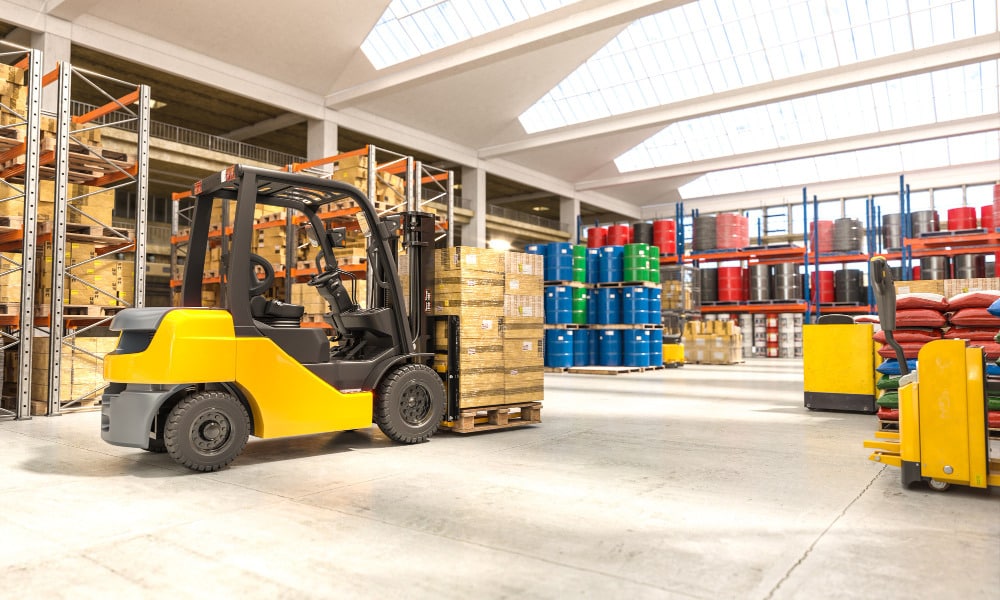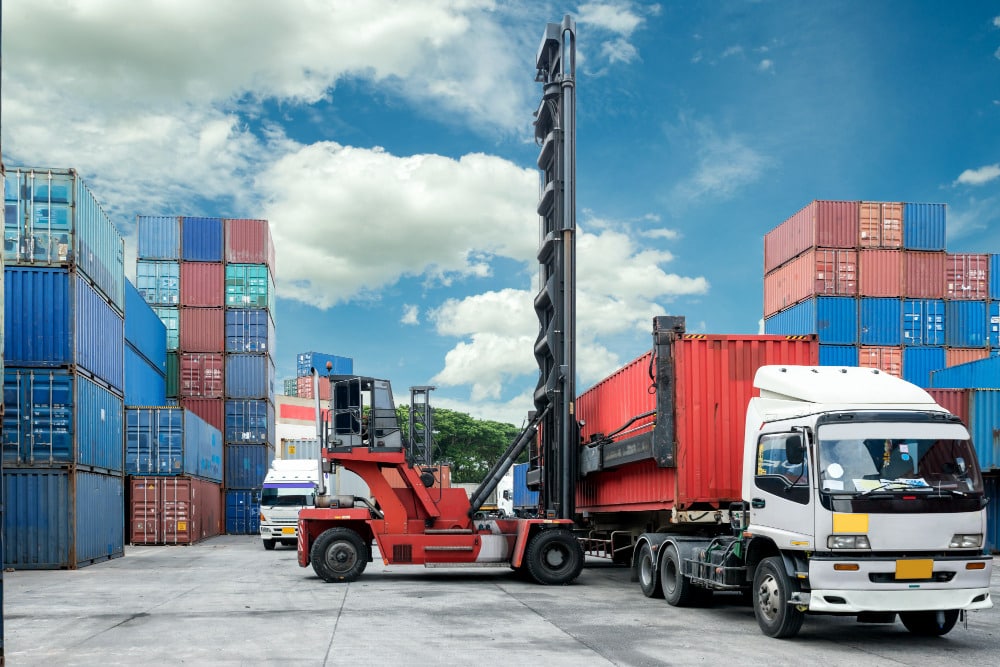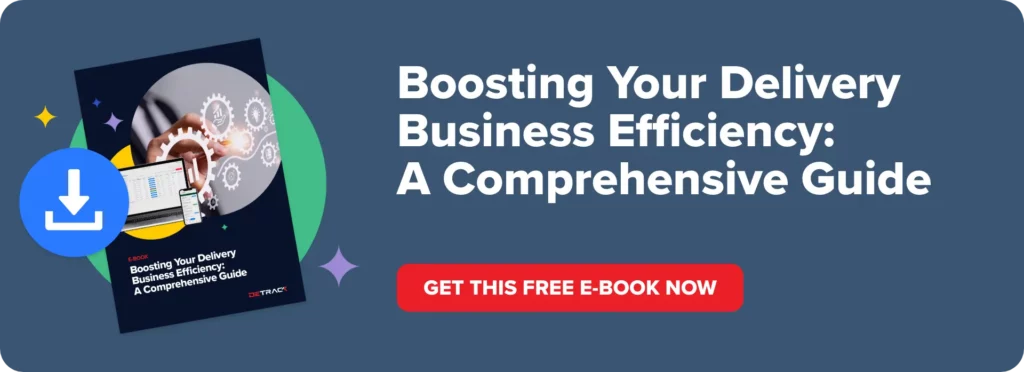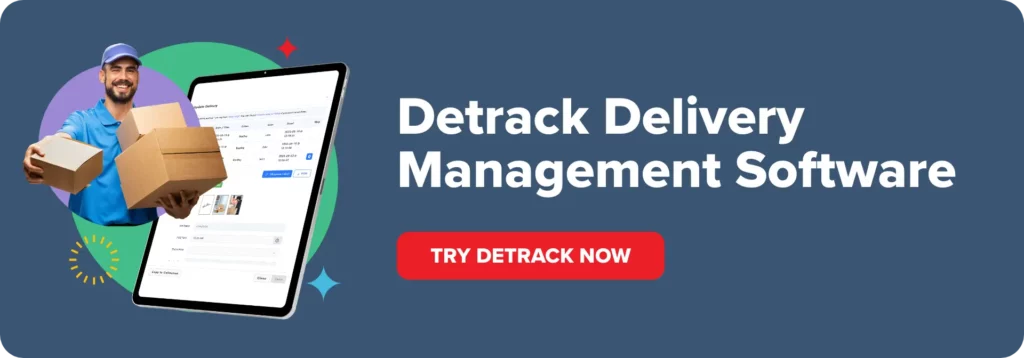In logistics, navigating through a sea of abbreviations and acronyms is crucial for effective communication and operational efficiency. Understanding these terms streamlines processes fosters collaboration, and ensures smooth coordination across various facets of the supply chain.
The array of abbreviations and acronyms encompass various dimensions of logistics.
Optimize Your Deliveries Before They Fall Through the Cracks
Get real-time updates, optimize routes, and improve operational efficiency with Detrack.
General Logistics Abbreviations
1. 3PL – Third-Party Logistics
Third party logistics companies offer outsourced logistics services, managing various supply chain elements, such as transportation, warehousing, and fulfillment. They act as intermediaries between businesses and carriers, providing expertise and resources to streamline logistics operations.
2. 4PL – Fourth Party Logistics
A higher-level logistics provider that typically oversees the entire supply chain network. A 4PL often acts as a consultant or integrator, coordinating multiple 3PLs and other parties involved in the supply chain. Their role involves strategic planning, optimization, and coordination to enhance efficiency and reduce costs across the supply chain.
3. FTL – Full Truckload
Refers to shipments that occupy the entire capacity of a truck. FTL shipments are typically more cost-effective for larger volumes or goods that require dedicated transportation without sharing space with other cargo.
4. LTL – Less Than Truckload
Describes shipments that don’t require the total capacity of a truck. LTL shipments share space with other goods heading in the same direction, allowing multiple shippers to split the transportation costs. Carriers consolidate and transport smaller shipments to optimize truck capacity and reduce costs.
5. BOL – Bill Of Lading
A legal document issued by the carrier to the shipper acknowledging the receipt of goods for shipment. It serves as a receipt, contract of carriage, and title document. The BOL contains details such as the type and quantity of goods, destination, and terms of shipment.
6. CFS – Container Freight Station
This is a designated area or warehouse where consolidated cargo is received, sorted, and prepared for loading into shipping containers. CFS facilities are crucial in consolidating smaller shipments into containers for efficient transportation.
7. DRP – Distribution Requirement Planning
A process that involves forecasting, planning, and managing the movement of goods from the manufacturer or supplier to the end customer. DRP focuses on ensuring the right products are available within the supply chain at the right place and time.
8. ETA – Estimated Time of Arrival:
ETA is the anticipated time when a shipment is expected to reach its destination. ETA provides stakeholders with crucial information for planning and coordination, allowing for better resource allocation and scheduling.
9. ETD – Estimated Time of Departure
Refers to the anticipated time when a shipment is scheduled to leave its origin. ETD assists in planning and coordinating the logistics chain by estimating when goods will begin their journey.
10. JIT – Just In Time
An inventory management strategy aimed at receiving goods only as needed in production or distribution. JIT minimizes inventory holding costs and storage space while ensuring efficient production and reduced waste.
11. POD – Proof Of Delivery
A document or system confirming the successful delivery of goods to the intended recipient. POD includes details such as the recipient’s name, the date and time of delivery, and sometimes the recipient’s signature. It shows that the shipment reached its destination and is essential for billing, dispute resolution, and customer service.
12. ROE – Rate Of Exchange
The value of one currency in comparison to another. ROE is used in international trade and finance to determine the equivalent value of currencies when conducting transactions involving different currencies. Fluctuations in the ROE impact the cost and profitability of international trade.
13. SOP – Standard Operating Procedure
Established guidelines or step-by-step instructions detailing how specific organizational tasks or processes should be performed. SOPs ensure consistency, efficiency, compliance with regulations, and quality control across various logistics and supply chain operations.
14. TMS – Transportation Management System
A software platform used to plan, execute, and optimize transportation operations. TMS helps manage route planning, carrier selection, freight audit, and performance tracking. It aims to improve efficiency, reduce transportation costs, and enhance overall logistics management.
15. VMI – Vendor Managed Inventory
An inventory management system where the supplier or vendor takes responsibility for monitoring and replenishing a customer’s inventory. VMI allows suppliers to have real-time visibility into inventory levels and proactively manage stock, ensuring that customers maintain optimal inventory levels without stockouts or overstock situations.
16. WMS – Warehouse Management System
Software designed to efficiently manage warehouse operations, including inventory management, order fulfillment, picking, packing, and shipping. WMS optimizes warehouse processes, improves inventory accuracy, and enhances overall productivity within the warehouse environment.
17. ASN – Advanced Shipment Notice
A notification sent by a supplier or carrier to inform the recipient or customer about an upcoming shipment. ASN provides detailed information about the contents, quantity, expected delivery date, and other relevant details before the actual arrival of the shipment. This helps recipients prepare for the incoming goods and streamline receiving processes.
18. DC – Distribution Center
A facility used for receiving, storing, and distributing products within a supply chain. DCs act as hubs where goods are sorted, processed, and redistributed to fulfill orders efficiently. They play a critical role in maintaining inventory flow and meeting customer demand.
19. SCM – Supply Chain Management
The holistic management of interconnected activities involved in the creation and delivery of products or services, from raw material sourcing to end-user consumption. Supply chain management encompasses planning, procurement, production, logistics, and distribution while focusing on optimizing efficiency, cost-effectiveness, and customer satisfaction.
20. SLA – Service Level Agreement
A contract or agreement that defines the level of service expected between a service provider and a customer. SLAs outline specific metrics, responsibilities, performance measures, and remedies in case of service disruptions or failures. In logistics, SLAs ensure clarity and accountability between parties, fostering better relationships and service quality.

Transportation Logistic Acronyms
21. FOB – Free On Board
FOB refers to a shipping agreement where the seller is responsible for goods until they are loaded onto the transport vehicle at the specified location (usually a port). Once loaded, the responsibility transfers to the buyer, who bears the costs and risks of transportation from that point onward.
22. CIF – Cost, Insurance, and Freight
CIF is a shipping agreement where the seller covers the cost of goods, insurance, and freight to deliver the goods to the destination port. The seller is responsible for arranging and paying for transportation and insurance until the goods reach the destination port, after which the buyer takes over.
23. EXW – Ex Works
EXW is an arrangement where the seller’s responsibility ends when the goods are made available at their premises or another named place (like a factory or warehouse). The buyer assumes all transportation costs, risks, and responsibilities from that point forward.
24. LCL – Less than Container Load
LCL refers to a shipment that does not fill an entire container. Multiple shipments from different senders are consolidated into a single container to utilize space more efficiently and reduce costs for smaller shipments.
25. TEU – Twenty-foot Equivalent Unit
TEU is a standard measure used in the shipping industry to describe the cargo capacity of container ships. It represents the cargo capacity of a standard twenty-foot shipping container. Larger containers, such as forty-foot containers, are often measured in multiples of TEUs (e.g., 2 TEUs).
26. CPT – Carriage Paid To
Under CPT terms, the seller is responsible for delivering the goods to a named destination, covering the costs of transportation. Once delivered to the agreed-upon destination, the responsibility shifts to the buyer, who assumes the risks from that point onward.
27. CIP – Carriage and Insurance Paid To
Similar to CPT, but with the additional inclusion of insurance. The seller pays for transportation and insurance to deliver the goods to a named destination. Once delivered, the buyer takes over the risk and responsibility.
28. DDU – Delivered Duty Unpaid
In a DDU agreement, the seller is responsible for delivering the goods to a named destination but does not cover import duties or taxes. The buyer is responsible for paying these duties upon arrival at the destination.
29. DDP – Delivered Duty Paid
DDP terms mean that the seller is responsible for delivering the goods to the destination, including all costs and risks, including import duties and taxes. The seller assumes responsibility until the goods are delivered to the buyer at the specified location.
30. RORO – Roll On, Roll Off
RORO refers to a method of loading and unloading cargo onto vessels or transporters equipped with ramps. Vehicles or cargo can be driven or rolled onto the vessel at the port of origin and rolled off at the destination without the need for cranes or other loading equipment.
Warehousing Abbreviation for Logistics
31. ASRS – Automated Storage and Retrieval System
ASRS refers to a computerized system used in warehouses to automatically place and retrieve items from storage locations. It employs robotic mechanisms, conveyors, and software control systems to efficiently manage inventory storage and retrieval processes.
32. ABC – ABC Analysis (classification of inventory items)
ABC analysis is a method used to categorize inventory items based on their importance and value within a company’s inventory management system. It classifies items into three categories: A (high-value items with lower frequency), B (moderate-value items with moderate frequency), and C (low-value items with higher frequency). This classification helps prioritize inventory management efforts, focusing on high-value items to optimize inventory control.
33. FOD – Foreign Object Debris
FOD refers to any foreign material or object present in a system or environment that can potentially cause damage, accidents, or malfunctions. In warehouses or manufacturing facilities, FOD prevention measures are crucial to maintain safety and prevent damage to equipment or products.
34. COGS – Cost of Goods Sold
COGS represents the direct costs incurred in producing or purchasing goods that a company sells during a specific period. It includes costs such as materials, labor, and manufacturing overhead directly associated with the production of goods sold. COGS is essential for determining a company’s gross profit.
35. FOD – Foreign Object Damage
In contrast to Foreign Object Debris (FOD), Foreign Object Damage refers to actual physical harm or damage caused by foreign objects or materials. In logistics and aviation industries, FOD prevention programs aim to reduce the risk of damage caused by foreign objects to equipment, vehicles, or products.
36. HAZMAT – Hazardous Materials
HAZMAT refers to substances or materials that, due to their chemical or physical properties, present a risk to health, safety, property, or the environment. Proper handling, storage, transportation, and disposal of hazardous materials are regulated to ensure safety and prevent environmental damage.
37. MOQ – Minimum Order Quantity
MOQ represents the minimum quantity of products or materials that a supplier is willing to sell or a buyer is required to purchase in a single order. It helps suppliers manage production and buyers negotiate favorable pricing or terms.
38. EOQ – Economic Order Quantity
EOQ is the optimal order quantity that minimizes total inventory holding costs and ordering costs. It considers factors such as demand, carrying costs, and ordering costs to determine the most cost-efficient quantity to order for a given product.
39. FSN – Fast, Slow moving, and Non-moving (inventory classification)
FSN classification categorizes inventory items based on their movement or turnover rates. Fast-moving items have high turnover, slow-moving items have moderate turnover, and non-moving items have low or no turnover. This classification aids in inventory management, ensuring appropriate stocking levels and reducing carrying costs.
40. MTS – Make To Stock
MTS is a manufacturing strategy where products are produced based on anticipated demand and stocked in inventory before customer orders are received. This strategy is used for items with stable and predictable demand.
41. MTO – Make To Order
MTO is a manufacturing approach where products are only produced once an order is received from a customer. It allows for customization and reduces the need for maintaining large inventories of finished goods.
42. MPS – Master Production Schedule
MPS is a detailed plan specifying what products will be manufactured, in what quantities, and when they will be produced. It serves as a guideline for production activities, aligning manufacturing schedules with customer demand and available resources.
43. OEE – Overall Equipment Effectiveness
OEE is a metric used to measure the performance of manufacturing equipment or machinery. It assesses the effectiveness of equipment by considering availability, performance efficiency, and quality rate to identify opportunities for improvement.
44. QMS – Quality Management System
QMS is a set of policies, processes, and procedures implemented by an organization to ensure that products or services consistently meet or exceed customer requirements and comply with quality standards. It encompasses quality planning, control, assurance, and improvement.
45. UOM – Unit of Measure
UOM refers to the standard unit used to quantify or measure a product or item. It could be weight, length, volume, quantity, etc. Standardizing the unit of measure is essential for accurate inventory management and transactions within supply chain operations.

Logistics Compliance and Regulations Abbreviations
46. CFR – Code of Federal Regulations
CFR is a set of codified regulations issued by the U.S. federal government that covers a wide range of subjects, including but not limited to, food and drugs, transportation, commerce, and more. CFR outlines rules, guidelines, and standards enforced by various federal agencies in the United States.
47. GMP – Good Manufacturing Practice
GMP refers to a set of guidelines and standards designed to ensure that products are consistently produced and controlled according to quality standards. GMP is applied in industries like pharmaceuticals, food, cosmetics, and others to maintain product safety, quality, and efficacy.
48. HACCP – Hazard Analysis and Critical Control Points
HACCP is a systematic preventive approach to food safety that identifies, evaluates, and controls potential hazards in food production processes. It focuses on critical control points where hazards can be prevented, eliminated, or reduced to ensure food safety.
49. ISO – International Organization for Standardization
ISO is an international body that develops and publishes international standards to ensure quality, safety, and efficiency in various industries and sectors worldwide. ISO standards cover diverse areas such as quality management, environmental management, information security, and more.
50. MSDS – Material Safety Data Sheet
MSDS is a document containing information about the properties, handling, storage, and emergency measures related to hazardous substances. It provides details on potential hazards, safe handling procedures, and first-aid measures in case of exposure or accidents.
51. NDA – New Drug Application
NDA is a submission to the regulatory authority (such as the U.S. Food and Drug Administration – FDA) containing comprehensive data and information on a new pharmaceutical product seeking approval for marketing and sale.
52. QA – Quality Assurance
QA involves systematic activities implemented within an organization to ensure that products or services meet specified requirements and standards. It encompasses processes, procedures, and guidelines aimed at preventing defects and ensuring consistent quality.
53. QC – Quality Control
QC involves activities and techniques used to monitor and verify that products or services meet predefined quality standards. It includes inspections, testing, and analysis to identify and rectify deviations or defects in products before they are released to customers.
54. REACH – Registration, Evaluation, Authorization, and Restriction of Chemicals
REACH is a regulation established by the European Union (EU) that addresses the production, import, and use of chemical substances. It aims to enhance the protection of human health and the environment by managing the risks posed by chemicals.
55. TSCA – Toxic Substances Control Act
TSCA is a United States law that regulates the manufacture, importation, use, and disposal of chemical substances. It provides the Environmental Protection Agency (EPA) with authority to assess and manage the risks associated with chemical substances.
Procurement Logistics Acronyms
56. RFP – Request for Proposal
An RFP is a document or solicitation issued by a company or organization to prospective suppliers or vendors, inviting them to submit proposals that detail how they would address the company’s needs or requirements for a particular project or service.
57. RFI – Request for Information
An RFI is a preliminary document used to gather information from potential suppliers or vendors regarding their capabilities, products, services, or general information about their organization. It helps the buyer assess the market and potential suppliers before issuing a formal RFP or RFQ (Request for Quotation).
58. LOI – Letter of Intent
An LOI is a formal declaration expressing the intention of a party to engage in a particular activity or business transaction with another party. It outlines the basic terms and conditions of a potential agreement and serves as a preliminary agreement before the final contract is signed.
59. P2P – Procure to Pay
P2P refers to the entire process within an organization that starts from procurement (acquiring goods or services) through to the payment process. It involves activities such as requisitioning, purchasing, receiving, and invoice processing until the payment is made.
60. MOU – Memorandum of Understanding
An MOU is a non-binding agreement between two or more parties outlining the intentions and understanding between them regarding a specific project, collaboration, or partnership. It lays the groundwork for further negotiations and formal agreements.
61. SLA – BPA – Blanket Purchase Agreement
An SLA is a formal contract or agreement that defines the level of service expected from a service provider. A BPA, on the other hand, is a type of long-term agreement between a buyer and a supplier where multiple purchases are made over time under pre-negotiated terms and conditions, often for recurring goods or services.
62. TCO – Total Cost of Ownership
TCO represents the total cost incurred throughout the lifespan of an asset, product, or service. It includes not only the initial purchase price but also costs associated with maintenance, operation, support, and disposal, providing a comprehensive view of the true cost of ownership.
63. SRM – Supplier Relationship Management
SRM involves managing and nurturing relationships with suppliers to ensure an efficient and productive supply chain. It encompasses strategies, processes, and technologies aimed at maximizing value and collaboration with suppliers.
64. ARO – After Receipt of Order
ARO refers to specific terms and conditions in a contract that outline the responsibilities and actions required after the receipt of an order by a buyer or supplier, such as delivery timelines, invoicing procedures, or quality inspections.
65. SOW – Statement of Work
An SOW is a document that outlines the specific details, objectives, deliverables, scope, and expectations of a project or work to be performed. It serves as a foundation for contracts and agreements between parties involved.
66. OTIF – On Time In Full
OTIF is a key performance indicator measuring the percentage of orders or deliveries completed on time and in full, without any delays or shortages. It reflects the efficiency and reliability of a supplier or logistics provider.
67. PPV – Purchase Price Variance
PPV refers to the difference between a purchased item’s standard or expected cost and its actual cost. It measures variations in the purchase price of materials or goods compared to the planned or budgeted price.
68. PR – Purchase Requisition
A PR is a formal request or document issued within an organization to request the purchase of goods or services. It initiates the procurement process by specifying the details of the items needed and the reasons for the purchase.
69. RFx – Request for [Proposal, Information, Quotation]
RFx is a generic term used to represent various formal requests made by a buyer to potential suppliers, including Requests for Proposal (RFP), Requests for Information (RFI), Requests for Quotation (RFQ), etc.
70. TCO – Total Cost of Ownership: (Repeated from the earlier list)
TCO represents the comprehensive cost incurred throughout the lifespan of an asset, product, or service, including initial purchase, maintenance, operation, support, and disposal costs.
Beyond Abbreviations: Next Steps in Your Business
Understanding these abbreviations is just the starting point toward optimizing operations and fostering successful business relationships. Leveraging these industry-standard acronyms empowers professionals to communicate effectively, streamline processes, and adhere to compliance and regulatory standards within their respective domains.
As businesses strive for efficiency, reliability, and customer satisfaction, they must go beyond mere acronyms and embrace innovative solutions. Services like Detrack offer cutting-edge technology to enhance logistics operations without sacrificing simplicity or user-friendliness.
Detrack’s platform provides real-time tracking, proof of delivery, and comprehensive analytics to streamline last-mile delivery operations. While ensuring the safe and efficient movement of goods, Detrack’s solutions offer transparency and reliability in the delivery process, contributing to improved customer experiences and operational efficiency.
To further explore how Detrack can revolutionize your logistics processes, streamline deliveries, and elevate customer satisfaction, take the next step toward optimized logistics management. Connect with Detrack today and embark on a journey toward enhanced operational excellence.
Optimize Your Deliveries Before They Fall Through the Cracks
Get real-time updates, optimize routes, and improve operational efficiency with Detrack.












